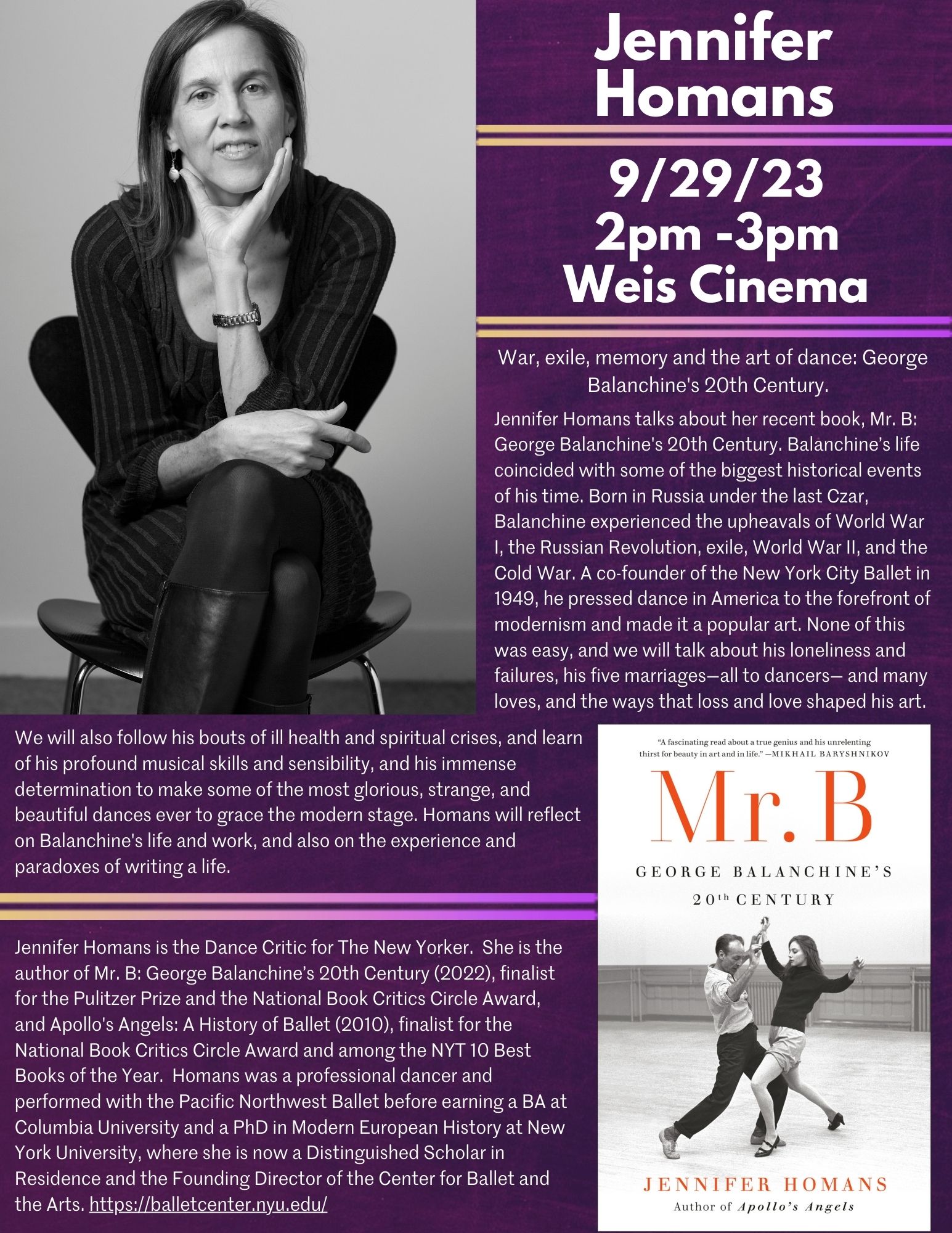Dean of the College and Dance Program Present
War, Exile, Memory, and the Art of Dance: George Balanchine’s 20th Century
Friday, September 29, 2023
Campus Center, Weis Cinema
2:00 pm – 3:00 pm EDT/GMT-4
2:00 pm – 3:00 pm EDT/GMT-4
A Discussion with Jennifer Homans
Jennifer Homans talks about her recent book, Mr. B: George Balanchine's 20th Century. Balanchine’s life coincided with some of the biggest historical events of his time. Born in Russia under the last Czar, Balanchine experienced the upheavals of World War I, the Russian Revolution, exile, World War II, and the Cold War. A co-founder of the New York City Ballet in 1949, he pressed dance in America to the forefront of modernism and made it a popular art. None of this was easy, and we will talk about his loneliness and failures, his five marriages—all to dancers— and many loves, and the ways that loss and love shaped his art. We will also follow his bouts of ill health and spiritual crises, and learn of his profound musical skills and sensibility, and his immense determination to make some of the most glorious, strange, and beautiful dances ever to grace the modern stage. Homans will reflect on Balanchine's life and work, and also on the experience and paradoxes of writing a life. Mr. B:George Balanchine’s Twentieth Century, tells the epic story of one
of the greatest choreographers of our time. Born in Imperial St. Petersburg in 1904, Balanchine
survived as a child, barely, World War One and the Russian Revolution. He saw broken bodies
and gruesome death, the human form destroyed, and in his own dances, he started over,
building with the sticks and bones of the old, ruined Imperial art, and with everything he picked
up as he went along, to invent a whole new way of dancing that pressed ballet to the forefront of
modern art.
Homans’ book, a decade in the making and based on over 100 interviews and research in
archives across Russia, Europe, and the Americas, carries us through Balanchine’s tumultuous
and high- pitched life and into the making of his extraordinary dances. We follow his path
through the Russian avant-garde and into exile, where he joined with Diaghilev’s Ballets Russes
and worked with Matisse and Picasso; Ravel and Stravinsky; surrealism, Dada and
expressionism. We see him flee Europe in 1933 for NYC, where he founded, with Lincoln
Kirstein, the NYCB in 1948. None of this was easy, and Homans shows us his loneliness and
failed companies, his five marriages—all to dancers— and many loves. We follow his bouts of ill
health and his spiritual crises, and learn of his profound musical skills and sensibility, and his
immense determination to make some of the most glorious and beautiful, strange, absurd, and
at times gruesome dances ever to grace the modern stage.
Balanchine lived through his dancers. He was not like Mozart or Einstein or Picasso working
alone to change the way people hear or think or see. He needed music and a whole theatrical
enterprise, but dancers above all. His gift didn’t exist without them, and he gathered them and
shaped them, making his own paints and pigments from their flesh and blood. Making dances
was personal, psychological, intimate even, and because women were his primary material, and
because he was a man who loved women, eroticism and love were always a part of it. As a
man, Balanchine was deeply human, but also genuinely otherworldly—not of this life, and he
knew it. His dances depended on the dancers he loved who, in some alchemy of art, were also
him. They called him ‘Mr. B.’
For more information, call 845-758-7970, e-mail jlown@bard.edu,
or visit https://dance.bard.edu.
Time: 2:00 pm – 3:00 pm EDT/GMT-4
Location: Campus Center, Weis Cinema
